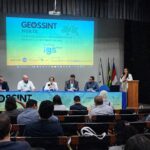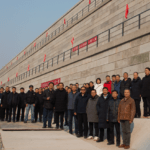Increasing sustainability content in university curriculums and a better framework to measure infrastructure performance, are key ways to help geosynthetics positively impact the planet.
That’s according to Dr Dipanjan Basu, who spoke to IGS Secretary General Edoardo Zannoni for our Two For A Few interview series.
Edoardo stole a few moments to chat to Dr Basu at the recent 17th African Regional Conference on Soil Mechanics and Geotechnical Engineering in October 2019.
The conference was organized by the South African Institution of Civil Engineering’s Geotechnical Division, part of the International Society of Soil Mechanics and Geotechnical Engineering (ISSMGE). Dr Basu is Chair of ISSMGE’s technical committee on sustainability and geotechnical engineering.
Dr Basu, Associate Professor at the University of Waterloo in Canada, said: “We need to introduce sustainability in the curriculum of civil and geotechnical engineering for undergraduate and postgraduate courses. We also need to establish a robust sustainability assessment framework, which I don’t think exists right now in geotechnical practices.”
He continued: “Geotechnical engineering practices require knowledge of sustainability to a great extent because we use a lot of resources, we generate a lot of waste and emissions. Therefore, as geotechnical engineers working in a multidisciplinary framework, it is necessary we understand how sustainability affects our profession and how we affect the world in general from a sustainability point of view.”
During the three-day conference in Cape Town, South Africa, Dr Basu delivered a short course on ‘Sustainability in Geotechnical Engineering’, sharing the latest developments in this important area. His talk described the connection between sustainability and engineering, examples of principles in action including the re-use and recycle of materials, construction methods to reduce carbon footprint, and the use of geotechnics for renewable energy.
Edoardo asked the sustainability ambassador what barriers he had faced in trying to bring the issue to the fore.
Dr Basu acknowledged there was some skepticism amongst peers at the beginning, and even initial resistance during the formation of his technical committee, but over time likeminded advocates rallied to give this important issue prominence.
The geotechnical engineer admitted: “I also had doubts; is [sustainability in geosynthetics] important or is this a buzzword? I convinced myself there is value in understanding sustainability and connecting it to our practices.
“I feel more resonance among people.”
Edoardo asked how sustainability could become integral to course curriculums. Dr Basu explained how it worked at his institution.
“In Waterloo we have three geotechnical courses. In the third I can freely introduce sustainability because this course is about case studies, so it’s much more flexible. Sometimes I also offer independent study courses to graduate students. We look at what sustainability means, how it is connected to geotechnical engineering, and how we can use the different tools to quantify sustainability for geotechnical engineering,” he said.
Dr Basu welcomed the change in mindset which allowed a greater acceptance for sustainability teaching.
He said his research also contributed to improving understanding as it focused on renewable energy in geotechnics and developing a combined sustainability and resilience assessment framework for geotechnical engineering.
He added: “The impact will show up at some point in time. I’m quite optimistic about it.”
Dr Basu also quizzed Edoardo about what the IGS was doing to impact sustainable development.
Edoardo said it was IGS’s mission to continually develop this aspect, giving examples of replacing granular and related natural materials with geosynthetics, the role geosynthetics have in helping to preserve water reserves as barrier systems in ponds and lagoons, the containment of waste, and preventing erosion which is becoming an increasing challenge with climate change.
Dr Basu added that research from a life cycle assessment aspect of geosynthetics found them to be more environmentally-friendly than alternatives.
The video can be found below and on our YouTube Channel.






















